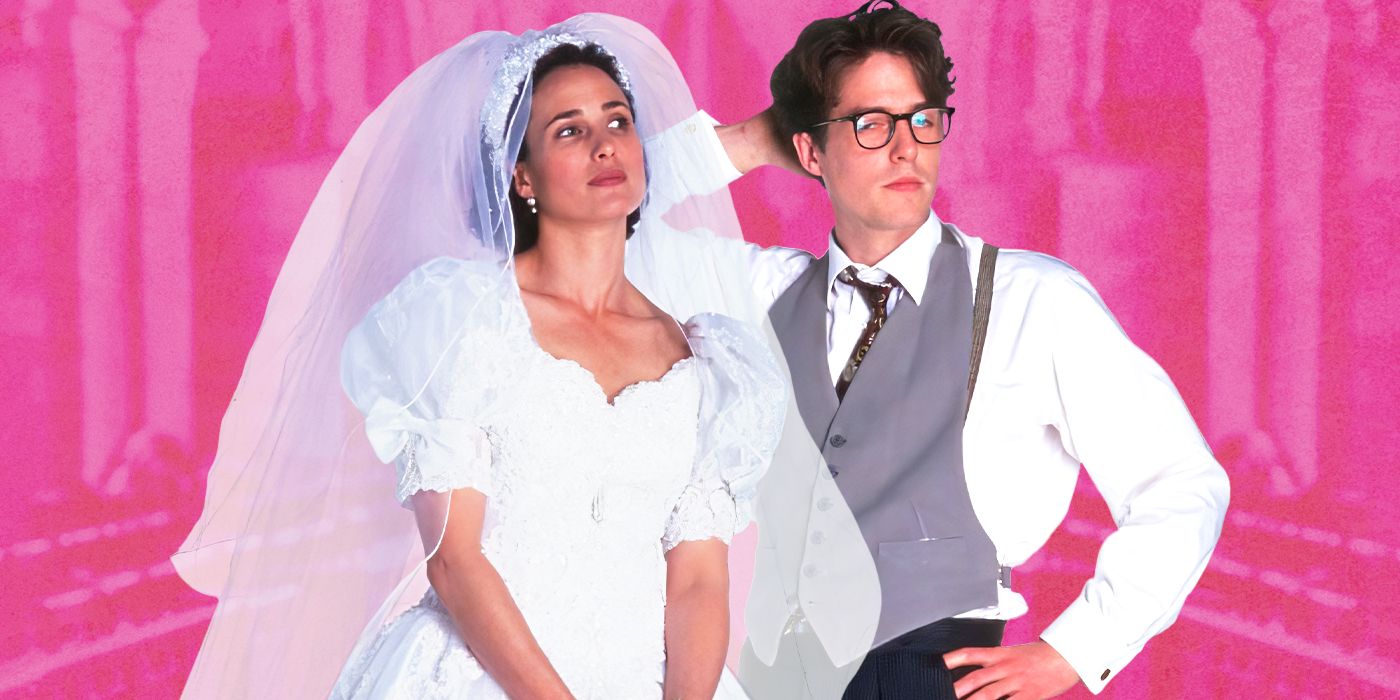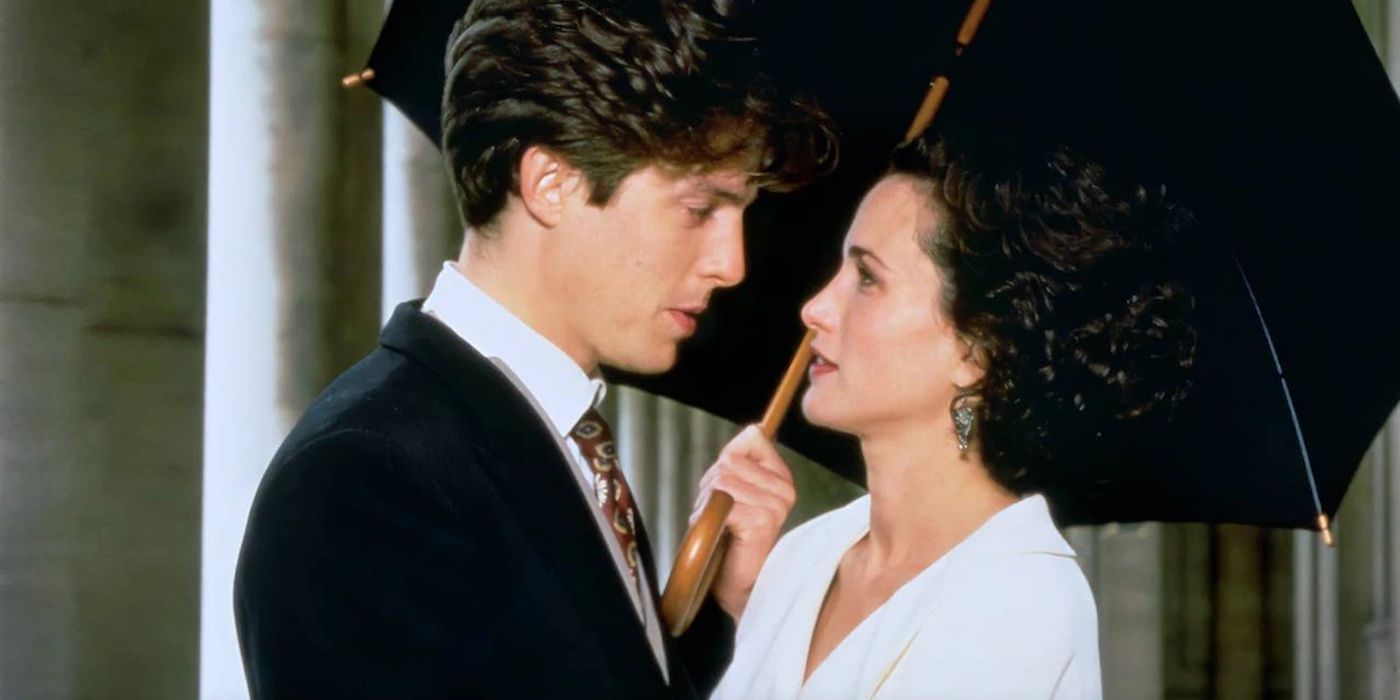1994 was one of the greatest years in film history, and you need no further evidence than by looking at the Best Picture line-up at the Academy Awards celebrating the year’s achievements. Forrest Gump, Pulp Fiction, The Shawshank Redemption, Quiz Show, and Four Weddings and a Funeral all became tremendously influential classics. While Four Weddings and a Funeral may seem like an oddity compared to the dramas that it was competing against, it’s hard to find another film that establishes and nails every romantic comedy beat in such expert fashion, courtesy of one of Richard Curtis’ most brilliant screenplays. What’s even more impressive is that Four Weddings and a Funeral is one of the best in its respective genre, even though the two leads have virtually no chemistry.
Directed by Mike Newell, Four Weddings and a Funeral follows the romantic single man Charles (Hugh Grant) over the course of a series of social engagements over the course of several years. Intertwined within Charles’ journey is his deaf brother David (David Bower), his friend Scarlett (Charlotte Coleman), another friend Fiona (Kristin Scott Thomas), her brother Tom (James Fleet), and the couple Gareth (Simon Callow) and Matthew (John Hannah). It’s Charles’ drunken attendance of a wedding between Angus (Timothy Walker) and Laura (Sara Crowe) that introduces him to the young American girl Carrie (Andie MacDowell), who immediately sends his heart into a flurry of emotions. Despite being a bachelor for almost all of his life, Charles can’t help but deny his attractions as their paths continue to coincide.
Neither Grant nor MacDowell give bad performances, but their romantic chemistry always feels off, and the film is often more interesting when they’re separated and longing for each other. However, this isn’t an impediment to the film, which has so many other merits that make it just as worthy of being in the “rom-com hall of fame.” The brilliant structure within Curtis’ script, expert pacing, and standout supporting players proved you don’t need chemistry to make a romance movie work.
'Four Weddings and a Funeral' Has a Brilliant Structure
As the title itself suggests, Four Weddings and a Funeral is primarily focused on five major moments that somehow bring these characters together. Curtis sets up an intriguing mystery; will any of them get married, and could we fall in love with a character doomed to die? Will Charles and Carrie be a happily married couple by the end, or will they bleakly see each other with another partner? This captivating hook does a lot to create interest in their relationship, even if the scenes between Grant and MacDowell aren’t as captivating.
To be fair, part of the reason that the two feel so hard to relate to on an emotional level can be explained through the characterization. Charles is a bit of a womanizer who has never been able to stay committed, and so his failures to start off on the right foot with Carrie seem like he’s simply falling back into old habits. We see more than a few examples of Charles’ ignorance; he’s unaware that Fiona has been in love with him for their entire lives before she makes the heartbreaking reveal that she’s never married out of her hope that he’d recognize her one day. Similarly, Charles’ marriage to Henrietta (Anna Chancellor) seems to come at an impromptu moment only ten months after his previous flirtations with Carrie; it’s evident that he’ll rush into relationships before he’s had time to process his feelings.
Carrie’s confusion, and lack of initial appreciation of Charles, can also be explained as a result of her somewhat lack of familiarity with British customs. She’s constantly going back and forth between the United States and the United Kingdom, facing a revolving set of career prospects that overwhelm her. She’s also intending to marry her Scottish fiancée Hamish (Corin Redgrave), and so there’s less reason for her to have any interest in Charles. The two characters are purposefully at different stages in their lives; Four Weddings and a Funeral is about how they evolve as individuals long before they could ever come together.
'Four Weddings and a Funeral' Has Standout Side Characters
Four Weddings and a Funeral doesn’t even need the audience to invest in the leads because of how great everyone else in the film’s sprawling ensemble is. Even if Charles and Carries’ relationship is the entry point into the story, the film functions as an ensemble piece that shares critical moments and memories from each of their lives. It gives the audience an investment in the two leads because any social function they attend together will give us another snapshot into a major event. In fact, the other characters seem to often comment and criticize both Carrie and Charles for their less-than-shrewd decision-making.
Gareth and Matthew are easily the scene-stealers in Four Weddings and a Funeral; the gregarious couple is simply delightful during the opening moments in Somerset, and it gets even funnier once Gareth decides to try pairing each of his friends off amidst Carrie’s wedding to Hamish. The audience has come to rely on Gareth’s advice, and thus it’s even more heartbreaking when the titular “funeral” is revealed to be his. It’s an emotional gut punch that forces all the characters, particularly Charles, to wonder what true love really is, and if it’s always doomed to end in tragedy. It also introduces the idea that “true love” and “marriage” aren’t necessarily the same thing; Gareth and Matthew were never officially married, but was there any other couple that was more loyal and committed to one another?
When audiences reflect on Four Wedding and a Funeral, it’s rarely the interactions between Grant and MacDowell that they remember. Grant’s best scene in the film, when he’s punched out by his bride at their own wedding, happens when Carrie is off-screen; the joyous ending montage serves as a catalog of everyone’s experiences rather than just the central couple. It’s a skill that Curtis has mastered within his ensemble pieces, as you are always going to find one storyline that’s less intriguing than the others. In Four Weddings and a Funeral, that one just so happens to be the seemingly central relationship.


